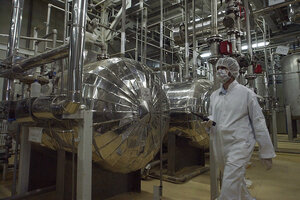Iranian nuclear enrichment signals resistance to US sanctions
The Atomic Energy Organization of Iran reopened a plant that converts yellowcake – an ingredient that can be used in nuclear power plants or atomic bombs – into gas, calling attention to the uncertain future of the country's international nuclear deal.

An Iranian security official walks through the Uranium Conversion Facility on March 30, 2005 outside the city of Isfahan, Iran. Iran says it has restarted its nuclear program, but so far the country has claimed that its intentions are peaceful.
Vahid Salemi/AP
Tehran, Iran
Iran says it has restarted production at a "major" uranium facility involved in its nuclear program, though it still pledges to follow the terms of the country's landmark atomic deal now under threat after President Trump pulled the United States out of the accord.
Iranian comments about the Isfahan plant, which produces material needed to make enriched uranium, appear aimed at pressuring Europeans and others to come up with a way to circumvent new American sanctions.
Already, many international organizations are pulling back from promised billion-dollar deals with Tehran and the country's currency has entered a free-fall against the US dollar.
What comes next likely will resemble Iran's response to previous confrontation with the West over its contested atomic program.
The Atomic Energy Organization of Iran said in a statement late Wednesday that it reopened a plant that converts yellowcake, a uranium powder, into uranium hexafluoride gas. That gas is what scientists put inside of centrifuges to make enriched uranium that can be used in nuclear power plants or in atomic bombs. Iran long has said its program is peaceful, though the West and the United Nations point to work Iran did years earlier that could be used to weaponize its program.
The "production plant at Isfahan UCF Complex has been practically inactive since 2009 because of the lack of yellowcake in the country," the organization said in its statement. That marks an Iranian acknowledgement of something it denied back in 2009 – that it had exhausted its sole supply of yellowcake, which came under a deal that Iran's Shah Mohammad Reza Pahlavi made with apartheid South Africa in the 1970s.
Since the 2015 nuclear deal, Iran has purchased yellowcake from Kazakhstan and Russia, as well as mined its own domestically. The accord allows for that, but limits Iran's enrichment of uranium to 3.67 percent, enough to use in a nuclear power plant but far lower than the 90 percent needed for an atomic weapon.
Since Mr. Trump's decision to pull the US from the nuclear deal, Iran has sought to pressure other nations to stick with it. Iranian officials – from Supreme Leader Ayatollah Ali Khamenei on down – have vowed to boost the country's uranium enrichment capacity. The moves they have outlined would not violate the accord, but would allow Iran to quickly ramp up enrichment if the agreement unravels.
Officials also have appeared in state media video and pictures at Isfahan with advanced IR-2M, IR-4, and IR-6 centrifuges labeled in English in the background. Those models are all believed to produce three to five times more enriched uranium in a year than the IR-1s that Iran is allowed to use under the deal, according to Western anti-proliferation experts.
The Atomic Energy Organization of Iran also released a video Thursday showing the first drum of yellowcake being put through the reopened facility, located 255 miles south of Tehran, as dramatic music played in the background.
"It is important that the resumption of the Isfahan UCF ... provides for the fulfillment and execution of the supreme leader's order to prepare for an increase in enrichment capacity," the organization said in its statement late Wednesday.
Trump's hard line, as well as the US ordering its allies to stop buying Iranian crude oil, only increases the change of the wider nuclear deal collapsing. US Secretary of State Mike Pompeo said on Wednesday that Iran's "ambitions for wastefully expanding its nuclear program... only add to the suffering of the people of Iran."
A guide for what happens next likely can be seen in how Iran initially handled its nuclear confrontation with the West. In 2005, Iran acknowledged converting yellowcake into uranium tetrafluoride, a step below the uranium hexafluoride needed for centrifuges. While allowed under the terms of a then-European deal, it came as negotiations with Tehran had become deadlocked.
Iran a short time later removed UN seals from equipment to produce uranium hexafluoride, again stopping as negotiations with the West continued. But by February 2006, hard-line President Mahmoud Ahmadinejad ordered uranium enrichment to resume in earnest.
"Iran's decision to master nuclear technology and the production of nuclear fuel is irreversible," Mr. Ahmadinejad would say, putting his country on a collision course with the West that saw crippling sanctions imposed.
For now, Iran remains governed by President Hassan Rouhani, a relative moderate with Iran's theocracy whose administration brokered the deal. However, Mr. Rouhani has faced increasing criticism from hard-liners, some of whom have openly called for the country to be run by military officials.
Final say on the nuclear program, however, rests with supreme leader Mr. Khamenei.
"In the face of the excessive demands of the opposite side, a courageous move must be made," Khamenei said in May.
This story was reported by The Associated Press.

